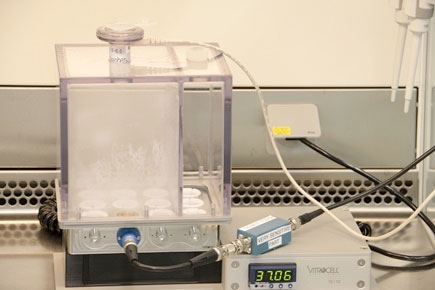| Posted: Oct 18, 2018 | |
What does graphene do in our lungs?(Nanowerk News) Graphene has been hailed as the material of the future. As yet, however, little is known about whether and how graphene affects our health if it gets into the body. A team of researchers from Empa and the Adolphe Merkle Institute (AMI) in Fribourg have now conducted the first studies on a three-dimensional lung model to examine the behavior of graphene and graphene-like materials once they have been inhaled. |
|
| Tensile, tear-proof, highly elastic and electrically conductive: Graphene has a startling array of extraordinary properties, which enable revolutionary applications in a vast range of fields. It is not by chance that the EU launched the Graphene Flagship project, which enjoys one billion Euros in funding and is the largest European research initiative. As part of this enormous project, Empa also brings its expertise to the table, since potential health aspects and the impact on the human organism also play a key role within the scope of this pan-European graphene research. | |
| These activities have now spawned an additional project funded by the Swiss National Science Foundation (SNSF), which was recently launched at Empa and AMI. It involves using a cellular 3D lung model, with the aid of which the researchers hope to find out what impact graphene and graphene-like materials might have on the human lung under conditions that are as realistic as possible. | |
| No mean feat: After all, not all graphene is the same. Depending on the production method and processing, a vast range of forms and quality spectra of the material emerges, which in turn can trigger different responses in the lung. | |
Three-dimensional cell cultures “inhale” particles |
|
| The research team headed by Peter Wick, Tina Bürki and Jing Wang from Empa and Barbara Rothen-Rutishauser and Barbara Drasler from AMI recently published their first results in the journal Carbon. | |
| Thanks to the 3D lung model, the researchers have succeeded in simulating the actual conditions at the blood-air barrier and the impact of graphene on the lung tissue as realistically as possible – without any tests on animals or humans. It is a cell model representing the lung alveoli. | |
 |
|
| The lung model at Adolphe Merkle Institute (AMI) in Fribourg (Image: AMI) | |
| Conventional in vitro tests work with cell cultures from just one cell type – the newly established lung model, on the other hand, bears three different cell types, which simulate the conditions inside the lung, namely alveolar epithelial cells and two kinds of immune cells – macrophages and dendritic cells. | |
| Another factor that has virtually been ignored in in vitro tests thus far is the contact with airborne graphene particles. Usually, cells are cultivated in a nutrient solution in a petri dish and exposed to materials, such as graphene, in this form. | |
| In reality, however, i.e. at the lung barrier, it is an entirely different story. “The human organism typically comes into contact with graphene particles via respiration,” explains Tina Bürki from Empa’s Particles-Biology Interactions lab. | |
| In other words, the particles are inhaled and touch the lung tissue directly. The new lung model is designed in such a way that the cells sit on a porous filter membrane at the air-liquid interface and the researchers spray graphene particles on the lung cells with the aid of a nebulizer in order to simulate the process in the body as closely as possible. The three-dimensional cell culture thus effectively “breathes in” graphene dust. | |
No acute damage discovered |
|
| These tests with the 3D lung model have now yielded the first results. The researchers were able to prove that no acute damage is caused to the lung if lung epithelial cells come into contact with graphene oxide (GO) or graphene nanoplatelets (GNP). This includes responses such as sudden cell death, oxidative stress or inflammation. | |
| In order to also trace chronic changes in the body, the SNSF project is set to run for three years; long-term studies using the lung model are next on the agenda. Besides pure graphene particles, Wick and his team also expose the lung cells to rubbed graphene particles made of composite materials, which are classically used to reinforce polymers. | |
| Jing Wang from Empa’s Advanced Analytical Technologies lab is also involved. In order to estimate the number of graphene particles humans are exposed to as realistically as possible, Wang is studying and quantifying the abrasion of composite materials. Based on this data, the team exposes the 3D lung model to realistic conditions and is able to make predictions regarding the long-term toxicity of graphene and graphene-like materials. |
| Source: By Cornelia Zogg, Empa | |
|
Subscribe to a free copy of one of our daily Nanowerk Newsletter Email Digests with a compilation of all of the day's news. |
